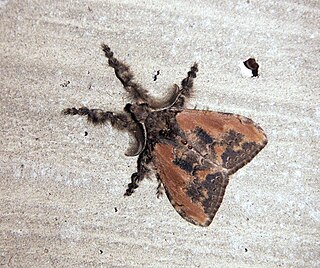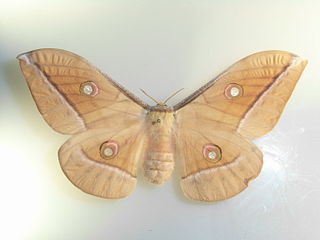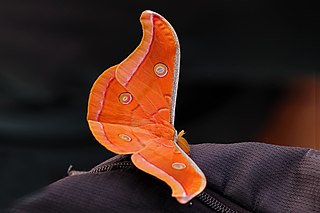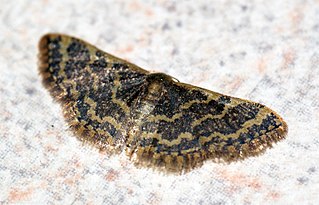Related Research Articles

Saturniidae, commonly known as saturniids, is a family of Lepidoptera with an estimated 2,300 described species. The family contains some of the largest species of moths in the world. Notable members include the emperor moths, royal moths, and giant silk moths.

The Saturniinae or saturniines are a subfamily of the family Saturniidae. They are commonly known as emperor moths or wild silk moths. They are easily spotted by the eyespots on the upper surface of their wings. Some exhibit realistic eye-like markings, whilst others have adapted the eyespots to form crescent moon or angular shapes or have lost their wing scales to create transparent windows. They are medium to very large moths, with adult wingspans ranging from 7.5 to 15 cm, in some cases even more. They consist of some of the largest groups of Lepidoptera like the moon or luna moth, atlas moth, and many more. The Saturniinae is an important source of wild silk and human food in many different cultures.

Olene mendosa, the brown tussock moth or hairy tussock moth, is a moth of the family Erebidae. The species was first described by Jacob Hübner in 1823. It is found in India, Bangladesh, Sri Lanka, Indonesia, Taiwan, Thailand and Australia.

Antheraea is a moth genus belonging to the family Saturniidae. The genus was erected by Jacob Hübner in 1819. Several species of this genus have caterpillars which produce wild silk of commercial importance. Commonly called "tussar silk", the moths are named tussar moths after the fabric.

Antheraea assamensis, known as the muga silkworm as a larva and Assam silk moth as an adult, is a moth of the family Saturniidae. The species was first described by T. W. Helfer in 1837. It is found in Assam in northeast India where 99% of its production occurs.

Tussar silk is produced from larvae of several species of silkworms belonging to the moth genus Antheraea, including A. assamensis, A. mylitta, A. paphia, A. pernyi, A. roylei and A. yamamai. These silkworms live in the wild forests in trees belonging to Terminalia species and Shorea robusta as well as other food plants like jamun and oak found in South Asia, eating the leaves of the trees they live on. Tussar silk is valued for its rich texture and natural deep gold colour, and varieties are produced in many countries, including China, India, Japan, and Sri Lanka.

Antheraea pernyi, the Chinese (oak) tussar moth, Chinese tasar moth or temperate tussar moth, is a large moth in the family Saturniidae. The species was first described by Félix Édouard Guérin-Méneville in 1855. Antheraea roylei is an extremely close relative, and the present species might actually have evolved from ancestral A. roylei by chromosome rearrangement.

Scirpophaga incertulas, the yellow stem borer or rice yellow stem borer, is a species of moth of the family Crambidae. It was described by Francis Walker in 1863. It is found in Afghanistan, Nepal, north-eastern India, Sri Lanka, Bangladesh, Myanmar, Vietnam, Thailand, Malaysia, Singapore, Sumatra, Java, Borneo, Sumba, Sulawesi, the Philippines, Taiwan, China and Japan.

Antheraea paphia, the South India small tussore, is a species of moth of the family Saturniidae found in India and Sri Lanka.
Archips eupatris is a species of moth of the family Tortricidae first described by Edward Meyrick in 1908. It is found in Sri Lanka.

Antheraea mylitta is a species of moth in the family Saturniidae known commonly as the tasar silkworm and vanya silkworm. It is actually one of a number of tasar silkworms, species that produce Tussar silk, a kind of wild silk that is made from the products of saturniid silkworms instead of the domesticated silkworm. This species is native to India.
Artaxa digramma is a moth of the family Erebidae first described by Jean Baptiste Boisduval in 1844. It is found in India, Sri Lanka, Myanmar, Nepal, Java, Borneo, and recently from China.
Euproctis fraterna is a moth of the family Erebidae first described by Frederic Moore in 1883. It is found in the Maldives, India, Sri Lanka and the Seychelles.
Lymantria todara is a moth of the family Erebidae first described by Frederic Moore in 1879. It is found in India (Nilgiri) and Sri Lanka.

Amblychia angeronaria is a moth of the family Geometridae first described by Achille Guenée in 1858. It is found in Sri Lanka, northern India, Korea, Andaman Islands to Taiwan, Borneo, Sumatra, Korea Japan and Australia.

Idaea purpurea is a moth of the family Geometridae first described by George Hampson in 1891. It is found in India, Sri Lanka, Taiwan, the Andaman Islands, Peninsular Malaysia and Borneo.

Rivula basalis is a moth of the family Erebidae first described by George Hampson in 1891. It is found in South India, Sri Lanka, Indo-China, Thailand, South China, Taiwan, Java, Bali and Borneo.
Miresa albipuncta is a moth of the family Limacodidae first described by Gottlieb August Wilhelm Herrich-Schäffer in 1854. It is found in Sri Lanka, India and Nepal.
Cryptaspasma brachyptycha is a moth of the family Tortricidae first described by Edward Meyrick in 1911. It is found in Sri Lanka and Australia.
Nola analis is a moth of the family Nolidae first described by Wileman and West in 1928. It is found in India, Sri Lanka and Hong Kong.
References
- ↑ "Species Details: Antheraea cingalesa Moore, 1883". Catalogue of Life. Retrieved 2 March 2018.
- ↑ Koçak, Ahmet Ömer; Kemal, Muhabbet (20 February 2012). "Preliminary list of the Lepidoptera of Sri Lanka". Cesa News. Centre for Entomological Studies Ankara (79): 1–57 – via Academia.
- ↑ "Sri Lankan Tussar Silk Moth". Project Noah. Retrieved 2 March 2018.
- ↑ "Family Saturniidae (Insecta: Lepidoptera) of Sri Lanka: An Overview" (PDF). The Journal of Tropical Asian Entomology. Retrieved 2 March 2018.
| | This article on a moth of the family Saturniidae is a stub. You can help Wikipedia by expanding it. |